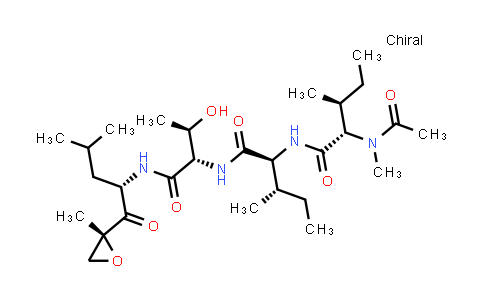| Chemical Name |
Epoxomicin |
| CAS Number |
134381-21-8 |
| MDL Number |
MFCD03791061 |
| Molecular Formula |
C28H50N4O7 |
| Molecular Weight |
554.72 |
| Synonyms |
BU-4061T |
Introduction of 134381-21-8 :
Epoxomicin (BU-4061T) is an epoxyketone-containing natural product and a potent, selective and irreversible proteasome inhibitor. Epoxomicin covalently binds to the LMP7, X, MECL1, and Z catalytic subunits of the proteasome and potently inhibits primarily the chymotrypsin-like activity. Epoxomicin can cross the blood-brain barrier. Epoxomicin has strongly antitumor and anti-inflammatory activity[1][2][3][4][5]. IC50 & Target: Proteasome[1] In Vitro: Epoxomicin shows quite potent cytotoxicities against all of the cells tested. Epoxomicin inhibits the cells growth of B16-F10, HCT116, Moser, P388 and K562 cells of IC50 values of 0.002 μg/mL, 0.005 μg/mL, 0.044 μg/mL, 0.002 μg/mL and 0.037 μg/mL[1].
Epoxomicin has antiproliferative activity with an IC50 of 4 nM in EL4 lymphoma cells[2]. In Vivo: Epoxomicin (0.063-1 mg/kg; intraperitoneal injection; once daily; for 9 days; male BDFX mice) treatment shows significant antitumor effect with the minimumeffective dose of 0.13mg/kg/day[1].
Epoxomicin also effectively inhibits NF-κB activation in vitro and potently blocks in vivo inflammation in the murine ear edema assay[3].
Epoxomicin is injected into adult rats over a period of 2 weeks. After a latency of 1 to 2 weeks, animals developed progressive Parkinsonism with bradykinesia, rigidity, tremor, and an abnormal posture. Postmortem analyses shows striatal dopamine depletion and dopaminergic cell death with apoptosis in the substantia nigra pars compacta[4].
| Purity |
NLT 98% |
| Storage |
at 20ºC 2 years |
*The above information is for reference only.
